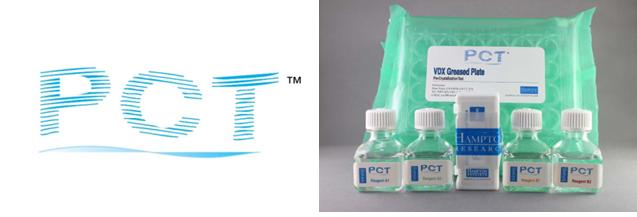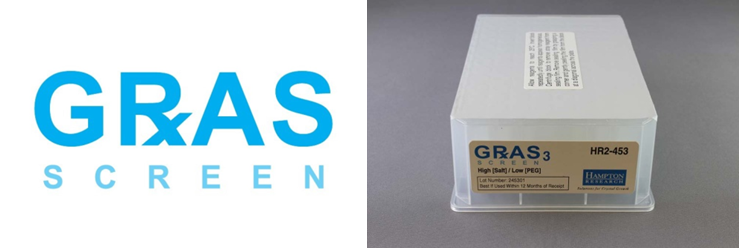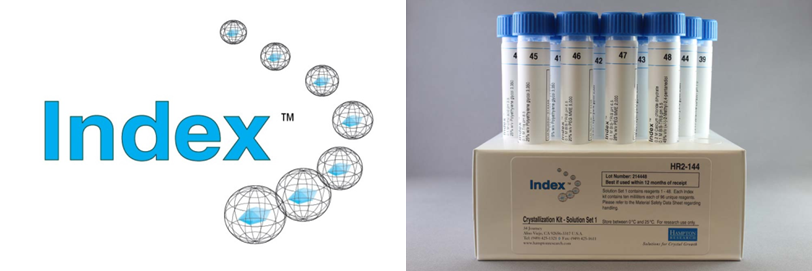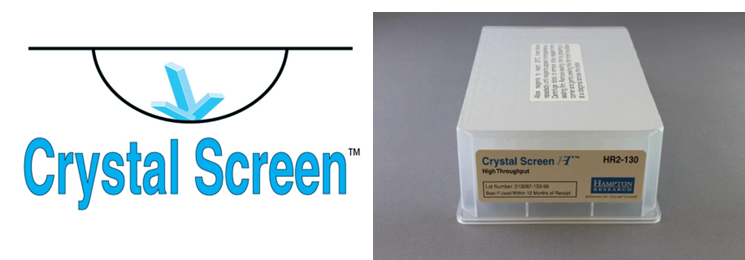Crystallization Screens

PCT™ Pre-Crystallization Test
應用
Determine the appropriate sample concentration for crystallization screening
特點
- Conserve sample
- Optimize sample concentration prior to initial screens
- Provide insight to sample homogeneity

GRAS Screens 1-8
應用
GRAS reagent crystallization screen for proteins, including monoclonal antibodies, (1&2) where Polyethylene glycol is the primary, and Salt the secondary reagent, sampling pH 4-9.(3&4) where Salt is the primary, and Polyethylene glycol the secondary reagent, sampling pH 4-9.(5&6) where Polyethylene glycol is the primary reagent, sampling pH 4.5 to 10. (7&8) where Salt is the primary reagent, sampling pH 4.5 to 10.
Identify GRAS based reagents that promote crystallization of biotherapeutics for bioprocess, bioformulation, and continuous flow manufacturing applications
特點
- Developed at Hampton Research
- Generally Recognized As Safe reagent formulation
- (1~4) Samples pH 4.0 - 9.0 without an added buffer
- (5~8) Samples pH 4.5 to 10; 8 unique buffers
- Primary crystallization reagent:
- GRAS Screen 1&5: PEG 300, 400, MME 550, & 600
- GRAS Screen 2&6: PEG 1,000, MME 2,000, 3,350, & 4,000
- GRAS Screen 3&4: 24 unique salts
- GRAS Screen 7: Ammonium - acetate, chloride, citrate, formate, phosphate, sulfate, tartrate, Potassium phosphate, & Sodium acetate
- GRAS Screen 8: Sodium - chloride, citrate, formate, phosphate & tartrate
- Secondary crystallization reagent:
- GRAS Screen 1&2: 24 unique salts
- GRAS Screen 3: PEG 300, 400, MME 550, & 600
- GRAS Screen 4: PEG 1,000, MME 2,000, 3,350, & 4,000
- Compatible with Vapor diffusion, microbatch, free interface diffusion
- Reagents soluble between 4°C and 30°C
- Antibody crystallization screen
- Membrane protein crystallization screen (1&2, 5&6)
- LCP compatible

Index • Index HT
應用
Primary, diverse reagent system crystallization screen for proteins, complexes, peptides, nucleic acids, & water soluble small molecules
特點
- Developed at Hampton Research
- A data-driven biased sparse matrix and grid screen
- Screens classic, contemporary, & modern crystallization reagents
- Samples pH 3 to 9
- Compatible with microbatch, vapor diffusion, & liquid diffusion methods
- Specially formulated reagent zones:
- Traditional salts versus pH
- Neutralized organic acids
- High [salt] with low [polymer]
- High [polymer] with low [salt]
- Low ionic strength versus pH
- PEG & Salt versus pH
- PEG & Salt
- Tube or Deep Well block format

Crystal Screen • Crystal Screen 2 • Crystal Screen HT
應用
Primary screen for proteins, soluble peptides, nucleic acids, & water soluble small molecules
Sparse matrix additive screen
特點
- The original sparse matrix screen
- Sparse matrix formula efficiently samples salts, polymers, organics, & pH
- Proven effective with more than 1,000 biological macromolecules
- Tube or Deep Well block format

Crystal Screen • Crystal Screen 2 • Crystal Screen HT
應用
Primary biased sparse matrix screen with cryo for proteins, soluble peptides, nucleic acids, & water soluble small molecules.
特點
- Developed at Hampton Research
- Cryo ready screening reagents for cryocrystallography
- Sparse matrix formula efficiently samples salts, polymers, organics, & pH
- Tube or Deep Well block format
- Screen for cryo and crystallization conditions using only one screen

